Shyam Sudhakaran
modl.ai
Human-like Bots for Tactical Shooters Using Compute-Efficient Sensors
Dec 30, 2024Abstract:Artificial intelligence (AI) has enabled agents to master complex video games, from first-person shooters like Counter-Strike to real-time strategy games such as StarCraft II and racing games like Gran Turismo. While these achievements are notable, applying these AI methods in commercial video game production remains challenging due to computational constraints. In commercial scenarios, the majority of computational resources are allocated to 3D rendering, leaving limited capacity for AI methods, which often demand high computational power, particularly those relying on pixel-based sensors. Moreover, the gaming industry prioritizes creating human-like behavior in AI agents to enhance player experience, unlike academic models that focus on maximizing game performance. This paper introduces a novel methodology for training neural networks via imitation learning to play a complex, commercial-standard, VALORANT-like 2v2 tactical shooter game, requiring only modest CPU hardware during inference. Our approach leverages an innovative, pixel-free perception architecture using a small set of ray-cast sensors, which capture essential spatial information efficiently. These sensors allow AI to perform competently without the computational overhead of traditional methods. Models are trained to mimic human behavior using supervised learning on human trajectory data, resulting in realistic and engaging AI agents. Human evaluation tests confirm that our AI agents provide human-like gameplay experiences while operating efficiently under computational constraints. This offers a significant advancement in AI model development for tactical shooter games and possibly other genres.
Making New Connections: LLMs as Puzzle Generators for The New York Times' Connections Word Game
Jul 15, 2024



Abstract:The Connections puzzle is a word association game published daily by The New York Times (NYT). In this game, players are asked to find groups of four words that are connected by a common theme. While solving a given Connections puzzle requires both semantic knowledge and abstract reasoning, generating novel puzzles additionally requires a form of metacognition: generators must be able to accurately model the downstream reasoning of potential solvers. In this paper, we investigate the ability of the GPT family of Large Language Models (LLMs) to generate challenging and creative word games for human players. We start with an analysis of the word game Connections and the unique challenges it poses as a Procedural Content Generation (PCG) domain. We then propose a method for generating Connections puzzles using LLMs by adapting a Tree of Thoughts (ToT) prompting approach. We evaluate this method by conducting a user study, asking human players to compare AI-generated puzzles against published Connections puzzles. Our findings show that LLMs are capable puzzle creators, and can generate diverse sets of enjoyable, challenging, and creative Connections puzzles as judged by human users.
Generative Design through Quality-Diversity Data Synthesis and Language Models
May 16, 2024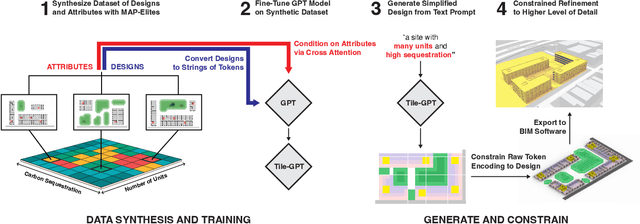

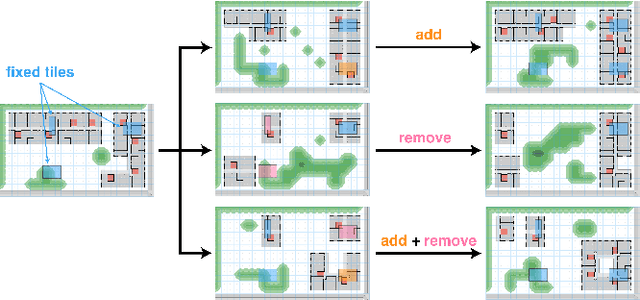
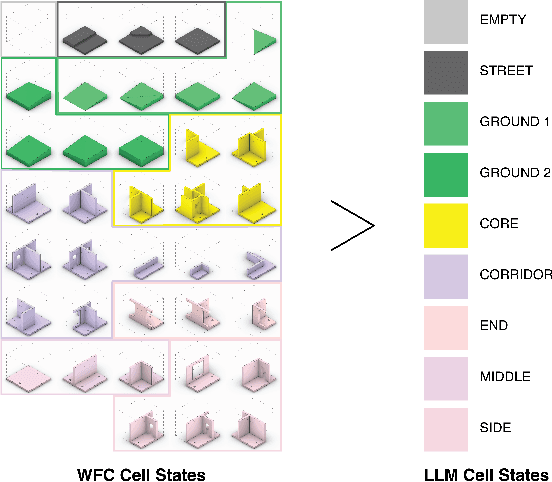
Abstract:Two fundamental challenges face generative models in engineering applications: the acquisition of high-performing, diverse datasets, and the adherence to precise constraints in generated designs. We propose a novel approach combining optimization, constraint satisfaction, and language models to tackle these challenges in architectural design. Our method uses Quality-Diversity (QD) to generate a diverse, high-performing dataset. We then fine-tune a language model with this dataset to generate high-level designs. These designs are then refined into detailed, constraint-compliant layouts using the Wave Function Collapse algorithm. Our system demonstrates reliable adherence to textual guidance, enabling the generation of layouts with targeted architectural and performance features. Crucially, our results indicate that data synthesized through the evolutionary search of QD not only improves overall model performance but is essential for the model's ability to closely adhere to textual guidance. This improvement underscores the pivotal role evolutionary computation can play in creating the datasets key to training generative models for design. Web article at https://tilegpt.github.io
Towards Self-Assembling Artificial Neural Networks through Neural Developmental Programs
Jul 17, 2023



Abstract:Biological nervous systems are created in a fundamentally different way than current artificial neural networks. Despite its impressive results in a variety of different domains, deep learning often requires considerable engineering effort to design high-performing neural architectures. By contrast, biological nervous systems are grown through a dynamic self-organizing process. In this paper, we take initial steps toward neural networks that grow through a developmental process that mirrors key properties of embryonic development in biological organisms. The growth process is guided by another neural network, which we call a Neural Developmental Program (NDP) and which operates through local communication alone. We investigate the role of neural growth on different machine learning benchmarks and different optimization methods (evolutionary training, online RL, offline RL, and supervised learning). Additionally, we highlight future research directions and opportunities enabled by having self-organization driving the growth of neural networks.
MarioGPT: Open-Ended Text2Level Generation through Large Language Models
Feb 12, 2023Abstract:Procedural Content Generation (PCG) algorithms provide a technique to generate complex and diverse environments in an automated way. However, while generating content with PCG methods is often straightforward, generating meaningful content that reflects specific intentions and constraints remains challenging. Furthermore, many PCG algorithms lack the ability to generate content in an open-ended manner. Recently, Large Language Models (LLMs) have shown to be incredibly effective in many diverse domains. These trained LLMs can be fine-tuned, re-using information and accelerating training for new tasks. In this work, we introduce MarioGPT, a fine-tuned GPT2 model trained to generate tile-based game levels, in our case Super Mario Bros levels. We show that MarioGPT can not only generate diverse levels, but can be text-prompted for controllable level generation, addressing one of the key challenges of current PCG techniques. As far as we know, MarioGPT is the first text-to-level model. We also combine MarioGPT with novelty search, enabling it to generate diverse levels with varying play-style dynamics (i.e. player paths). This combination allows for the open-ended generation of an increasingly diverse range of content.
Skill Decision Transformer
Jan 31, 2023Abstract:Recent work has shown that Large Language Models (LLMs) can be incredibly effective for offline reinforcement learning (RL) by representing the traditional RL problem as a sequence modelling problem (Chen et al., 2021; Janner et al., 2021). However many of these methods only optimize for high returns, and may not extract much information from a diverse dataset of trajectories. Generalized Decision Transformers (GDTs) (Furuta et al., 2021) have shown that utilizing future trajectory information, in the form of information statistics, can help extract more information from offline trajectory data. Building upon this, we propose Skill Decision Transformer (Skill DT). Skill DT draws inspiration from hindsight relabelling (Andrychowicz et al., 2017) and skill discovery methods to discover a diverse set of primitive behaviors, or skills. We show that Skill DT can not only perform offline state-marginal matching (SMM), but can discovery descriptive behaviors that can be easily sampled. Furthermore, we show that through purely reward-free optimization, Skill DT is still competitive with supervised offline RL approaches on the D4RL benchmark. The code and videos can be found on our project page: https://github.com/shyamsn97/skill-dt
Severe Damage Recovery in Evolving Soft Robots through Differentiable Programming
Jun 14, 2022Abstract:Biological systems are very robust to morphological damage, but artificial systems (robots) are currently not. In this paper we present a system based on neural cellular automata, in which locomoting robots are evolved and then given the ability to regenerate their morphology from damage through gradient-based training. Our approach thus combines the benefits of evolution to discover a wide range of different robot morphologies, with the efficiency of supervised training for robustness through differentiable update rules. The resulting neural cellular automata are able to grow virtual robots capable of regaining more than 80\% of their functionality, even after severe types of morphological damage.
HyperNCA: Growing Developmental Networks with Neural Cellular Automata
Apr 25, 2022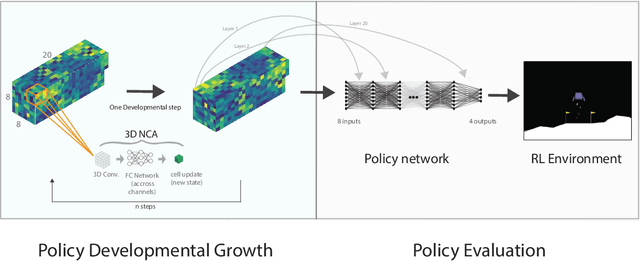

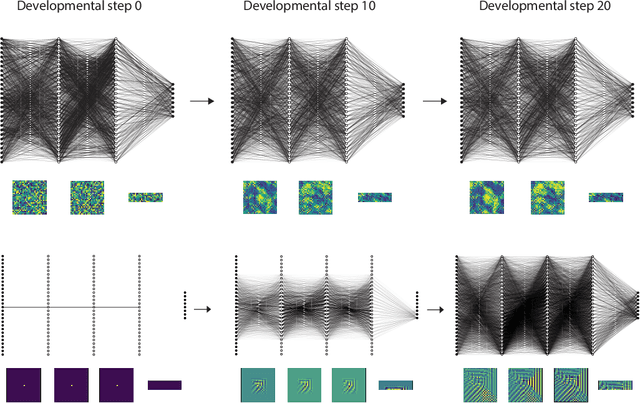
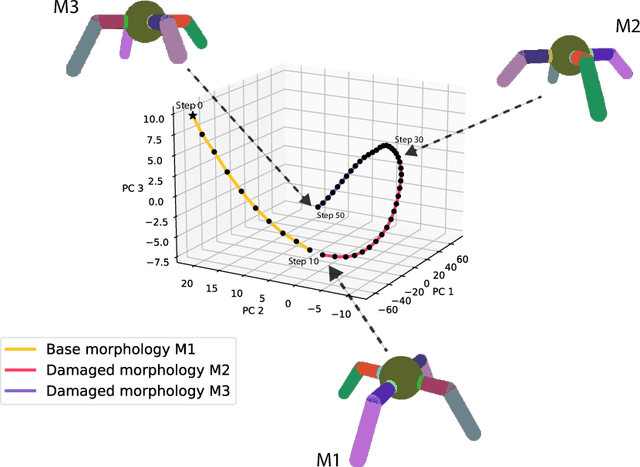
Abstract:In contrast to deep reinforcement learning agents, biological neural networks are grown through a self-organized developmental process. Here we propose a new hypernetwork approach to grow artificial neural networks based on neural cellular automata (NCA). Inspired by self-organising systems and information-theoretic approaches to developmental biology, we show that our HyperNCA method can grow neural networks capable of solving common reinforcement learning tasks. Finally, we explore how the same approach can be used to build developmental metamorphosis networks capable of transforming their weights to solve variations of the initial RL task.
Variational Neural Cellular Automata
Feb 02, 2022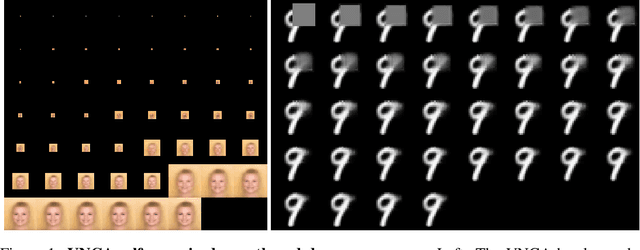
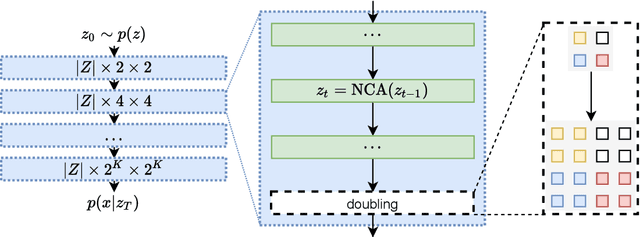

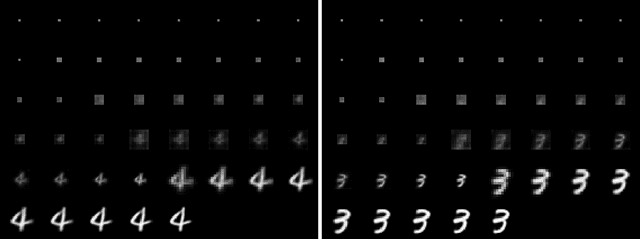
Abstract:In nature, the process of cellular growth and differentiation has lead to an amazing diversity of organisms -- algae, starfish, giant sequoia, tardigrades, and orcas are all created by the same generative process. Inspired by the incredible diversity of this biological generative process, we propose a generative model, the Variational Neural Cellular Automata (VNCA), which is loosely inspired by the biological processes of cellular growth and differentiation. Unlike previous related works, the VNCA is a proper probabilistic generative model, and we evaluate it according to best practices. We find that the VNCA learns to reconstruct samples well and that despite its relatively few parameters and simple local-only communication, the VNCA can learn to generate a large variety of output from information encoded in a common vector format. While there is a significant gap to the current state-of-the-art in terms of generative modeling performance, we show that the VNCA can learn a purely self-organizing generative process of data. Additionally, we show that the VNCA can learn a distribution of stable attractors that can recover from significant damage.
MuSLCAT: Multi-Scale Multi-Level Convolutional Attention Transformer for Discriminative Music Modeling on Raw Waveforms
Apr 06, 2021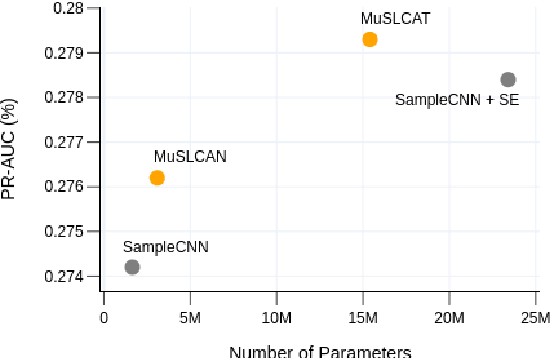
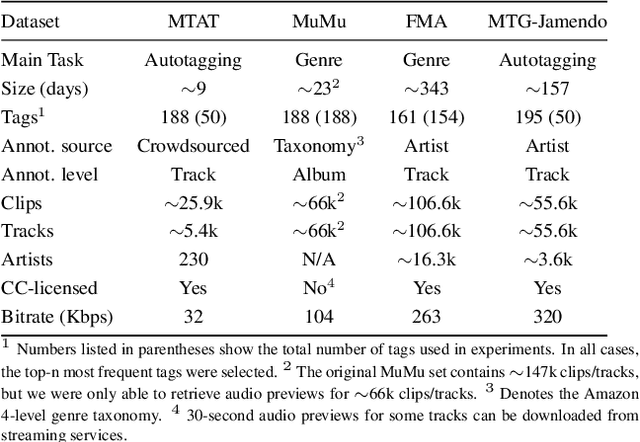
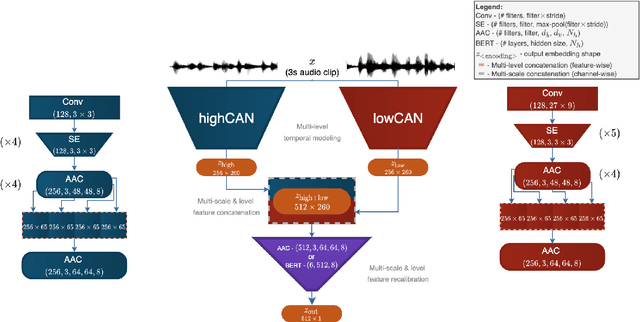

Abstract:In this work, we aim to improve the expressive capacity of waveform-based discriminative music networks by modeling both sequential (temporal) and hierarchical information in an efficient end-to-end architecture. We present MuSLCAT, or Multi-scale and Multi-level Convolutional Attention Transformer, a novel architecture for learning robust representations of complex music tags directly from raw waveform recordings. We also introduce a lightweight variant of MuSLCAT called MuSLCAN, short for Multi-scale and Multi-level Convolutional Attention Network. Both MuSLCAT and MuSLCAN model features from multiple scales and levels by integrating a frontend-backend architecture. The frontend targets different frequency ranges while modeling long-range dependencies and multi-level interactions by using two convolutional attention networks with attention-augmented convolution (AAC) blocks. The backend dynamically recalibrates multi-scale and level features extracted from the frontend by incorporating self-attention. The difference between MuSLCAT and MuSLCAN is their backend components. MuSLCAT's backend is a modified version of BERT. While MuSLCAN's is a simple AAC block. We validate the proposed MuSLCAT and MuSLCAN architectures by comparing them to state-of-the-art networks on four benchmark datasets for music tagging and genre recognition. Our experiments show that MuSLCAT and MuSLCAN consistently yield competitive results when compared to state-of-the-art waveform-based models yet require considerably fewer parameters.
 Add to Chrome
Add to Chrome Add to Firefox
Add to Firefox Add to Edge
Add to Edge